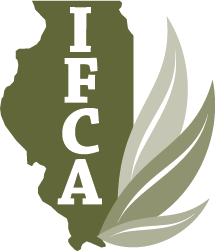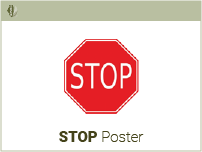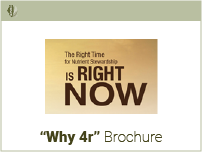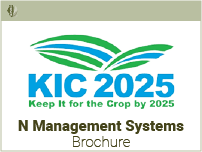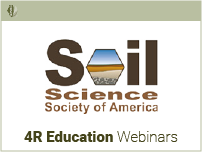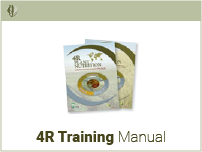Minimize Environmental Impact, Optimize Harvest Yield, Maximize Input Utilization
4R Nutrient Stewardship considers the agronomic, economic, environmental and social dimensions of nutrient management and is essential to sustainability of our Illinois agricultural production systems. The concept of the 4R system is to apply and/or recommend the right source of nutrient, at the right rate, at the right time, and in the right place based upon our expertise, training and knowledge of site-specific conditions of our customer’s fields.
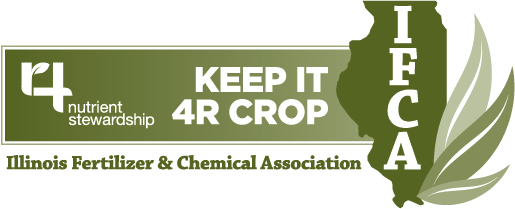
By committing to a 4R Code of Practice, (company name) will consistently work to provide education, support and implementation of the 4R practices outlined below with our farmer customers. These practices are based upon the research, recommendations and observations published in the University of Illinois Agronomy Handbook, which can be accessed at http://extension.cropsci.illinois.edu/handbook/
Crop nutrient management practices will be dictated by the goals of our farmer-customers, available resources, the cropping system, soil conditions, climatic conditions and other factors that influence any management decision. The outcomes of 4R implementation may vary year to year based upon these factors but the principles of the 4R Code of Practice provide a solid framework to minimize environmental impact, optimize harvest yield and maximize agricultural input utilization.
4R NUTRIENT CODE OF PRACTICES
-
For fall applied nitrogen, we will recommend waiting until maximum daily soil temperatures at the 4 inch level fall to 50° and temperatures are predicted to continue to decline.
-
We will recommend the stabilization of fall applied nitrogen fertilizers with labeled nitrification inhibitors.
-
We will not recommend the application of fertilizer on snow covered soils and will discourage the application of a majority of a customer’s nutrient needs on bare, frozen soils. When such requests are made, we provide 4R based management alternatives with the exception of fall sown cereal grains, perennial/permanent pastures and hay land. “Snow Covered” means no soil in the field of application can be seen due to snow cover. “Frozen” means soil conditions are such that tillage or incorporation after application is not possible at the time of application and will not be possible prior to weather conditions that could be conducive to excessive runoff from the field.
-
We will work with our customers to recommend nutrient application rates that are based upon agronomic and economic considerations as specified in the Illinois Agronomy Handbook, utilizing the MRTN calculator as the basis for establishing an initial target nitrogen recommendation which will be adjusted based on principles outlined in the following paragraph.
-
We will recommend managing nitrogen as a system, not as just an application. Managing nitrogen as a system gives consideration to the 4Rs of nutrient management (right source, right rate, right time, right place). This approach involves recommending a system that meets the farmer’s specific nitrogen needs and includes the use of nitrogen enhancement products that fit best within the nitrogen management system.
-
We recommend testing soils at least once every 4 years, preferably in the spring, to assess levels of phosphorus, potassium and pH and will recommend application rates based upon the Illinois Agronomy Handbook.
-
We will encourage our customers to follow proven crop production practices that will optimize yield and thus optimize nutrient utilization. Such practices include proper nutrient management, good pest control practices, scouting of fields and taking corrective action if needed to control pests during the growing season and timely harvest to minimize harvest loss.
4R EDUCATION & ACCOUNTABILITY
-
By committing to the 4R Code of Practice, we will allow the Illinois Fertilizer & Chemical Association (IFCA) to publish our company name as participating in this nutrient stewardship program on the IFCA Keep it 4R Crop website.
-
We will work with the IFCA to provide useful measurements on adoption of 4R practices within our trade territory in a manner that maintains the confidentiality of our farmer customers and also protects the confidentiality of our company’s business operations.
-
We will ensure that our management, sales team and operators are trained on the 4R Code of Practice and the fundamental principles of 4R Nutrient Stewardship. We will encourage employees to become Certified Crop Advisers, keep their certification in good standing and to attend specific programs offered on 4R principles.
-
We will provide and convey to our farmers customers information on 4R principles and the importance of following the 4R Code of Practice to minimize environmental impact, optimize harvest yield, and maximize agricultural input utilization.
-
We will encourage our farmer customers to participate in on-farm research, and to share those results with University nutrient researchers to strengthen, enhance and assure continual improvements to the nutrient recommendation systems contained within the Illinois Agronomy Handbook.
